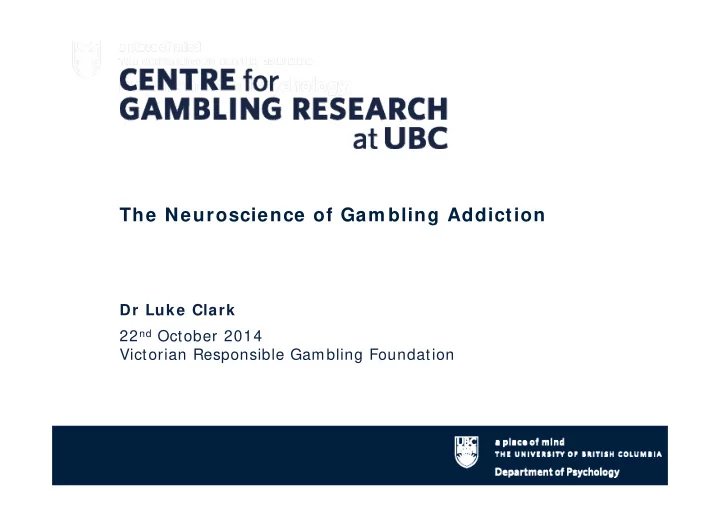

The Neuroscience of Gam bling Addiction Dr Luke Clark 22 nd October 2014 Victorian Responsible Gambling Foundation
Disclosure The Centre for Gambling Research at UBC is supported by the British Columbia Lottery Corporation and the Province of BC.
PG as the first behavioural addiction Reclassified from Impulse Control Disorders to Addictions Escalating wagers in DSM5 (and renamed (tolerance) ‘Gambling Disorder’) Withdrawal symptoms • Symptom hallmarks Repeated attempts to quit • Co-morbidities Pre-occupation • Shared heritability / genetics Gambling to escape Loss chasing • Effective treatments Lying about gambling • Neuroimaging / neurocognitive Lose relationship / job similarities Borrowing money
Disease m odel of problem gam bling Individual: Different Games Genetics Structural HOST AGENT Psychology Characteristics Neurobiology ENVI RONMENT Gambling Venue Legislation Korn & Shaffer 1999 Dow-Schull (2012)
Overview • Similarities and differences in the neurobiological signature of pathological gambling and substance addictions – Role of dopamine (PET imaging) – Functional MRI of reward processing • Measurement of gambling-related decision making – Cognitive distortions – Translational models
Dopam ine and Addiction 200 FOOD % of Basal Release 150 100 Empty 50 Feeding Box 0 0 60 120 180 Time (min) 1100 AMPHETAMINE 1000 900 % of Basal Release 800 700 600 500 400 300 200 100 0 0 1 2 3 4 5 hr Volkow et al Time After Amphetamine Courtesy of Barry Everitt
Dopam ine D2 Receptor Binding in PG Con Gam Controls Gamblers Clark et al (2012 NeuroImage)
I ncreased Dopam ine Release in PG Boileau et al (2014 Mol Psychiatry) Cf. Substance addictions: reduced dopamine release
Gam bling in Parkinson’s Disease • Corroborate data in primary PG (Steeves et al 09) • Time locking of DA receptor stimulation to PG • Related to other ICDs (hypersexuality, shopping)
minus Reuter et al (2005) losses Wins Functional im aging of gam bling tasks PG Con
van Holst et al (2012): during anticipation of reward, PG show increased activity in ventral striatum (and correlated with SOGS) Sescousse et al (2013): comparing monetary vs erotic rewards, PG show reduced response to non-gambling rewards ( imbalance ) Monetary rewards Erotic rewards Monetary cues Monetary > Erotic cue Erotic cues Reaction times (ms) Control cues % signal change y = 0 CONTROLS GAMBLERS GAMBLERS > CONTROLS CONTROLS GAMBLERS (n=20) (n=18)
Cognitive Approach to Gam bling • Gamblers experience distorted ??? processing of chance and skill , causing an over-estimation of chances of winning • Key examples – Gambler’s Fallacy – Illusion of Control • Elevated in problem gamblers and a target for cognitive therapy (Ladouceur) • Early studies measured with ‘think aloud’ technique and questionnaires (GBQ, GRCS)
Near-Misses “A special kind of failure to reach a goal, one that comes close to being successful” (Reid 1986) WIN NEAR ‐ MISS
Near Misses are Aversive but Enhance Motivation to Play Clark et al (2009 Neuron)
Skin Conductance Responses to Near-Misses Clark et al (2012 JoGS)
Brain Responses ( fMRI ) p< .05 FWE SLOT MACHINE WINS Midbrain Insula Striatum mPFC SLOT MACHINE NEAR-MISSES p< .001 uncorr Clark et al (2009 Neuron)
Gam bling I nvolvem ent and Near-Misses Clark et al (2009): Insula response to near misses and trait gambling cognitions Chase & Clark (2010): in regular players, midbrain response to near misses predicts PG symptoms
Gam bling distortions follow ing brain injury Injury to ventromedial PFC n= 17 Insula n= 8 Amygdala n= 7 Healthy controls n= 16 Clark et al (2014 PNAS)
Effects of Near Misses Most participants report increased motivation to play after near-miss outcomes compared to full-misses Effect abolished in insula group
The Gam bler’s Fallacy Most participants are less likely to choose RED after a run of consecutive REDs Effect abolished in group with insula damage
Role of the I nsula? - I nteroception Key reception zone for bodily input and arousal Gambling associated with increased physiological arousal (HR, cortisol) Skin conductance responses to wins and near-misses Insula overactivity in pathological gambling? Target for bodily treatments (e.g. mindfulness / biofeedback)
Gam bling rats? d Rodent slot machine (Winstanley et al, UBC) a b c Roll 10 sugar WIN pellets Roll LOSS 3 lights on 2 lights on 1 light on 0 lights on 10 s time-out near-miss near-loss CLEAR CLEAR WIN LOSS Slides courtesy of Paul Cocker
A translational m odel: dopam ine data NEAR- PD168077 (dopamine D4 agonist) MISSES • Rats respond to near-miss outcomes • Dopamine drugs modulate these responses (Winstanley et al 2011) • Preliminary evidence for D4 receptors (Cocker et al 2013)
Conclusions • PET and fMRI highlight similarities – but also some emerging differences – between problem gambling and substance use disorders • Neurosciences provide new tools for studying thinking and behaviour during gambling • Animal models of gambling decisions provide neurobiological precision that is not possible in humans • Relevance for treatment, disease classification and public awareness
Acknow ledgem ents Laboratory for Affect, Risk Antoine Bechara (USC) and Gambling Experiments (LARGE) Joel Bruss (Iowa) Bettina Studer (now UCL) Dan Tranel (Iowa) Mike Aitken Rosanna Michalczuk Imperial College, London Roseline Porchet Henrietta Bowden-Jones Steve Sharman Paul Stokes Eve Limbrick Oldfield Anne Lingford-Hughes Rachel Cocks Liese Mick Yin Wu Sophie Miller
www.cgr.psych.ubc.ca Twitter @CGR_UBC @LukeClark01 Email luke.clark@psych.ubc.ca
Recommend
More recommend